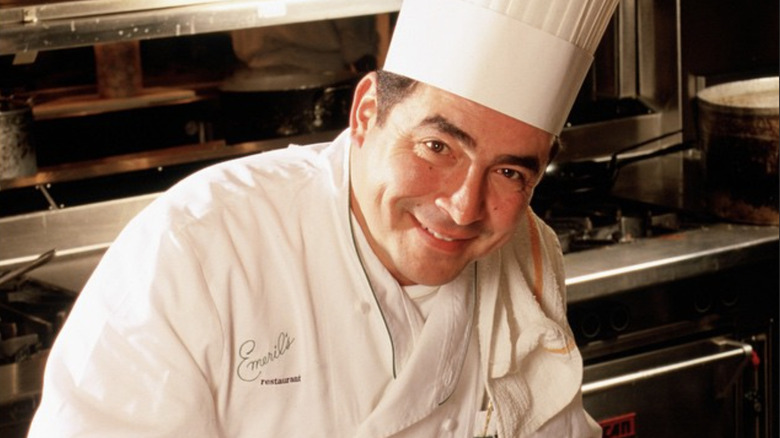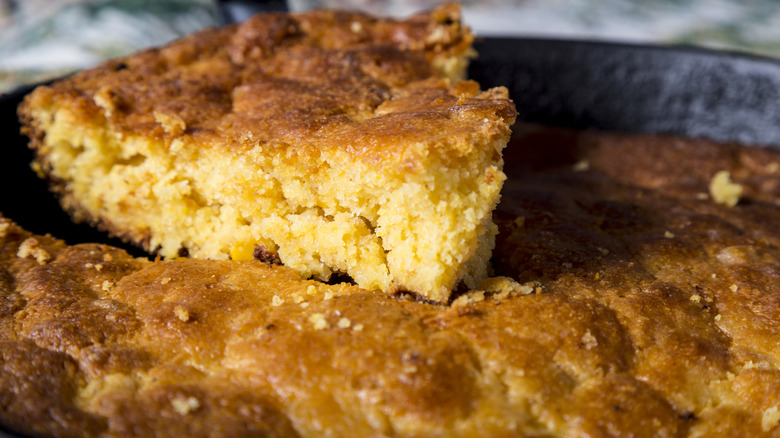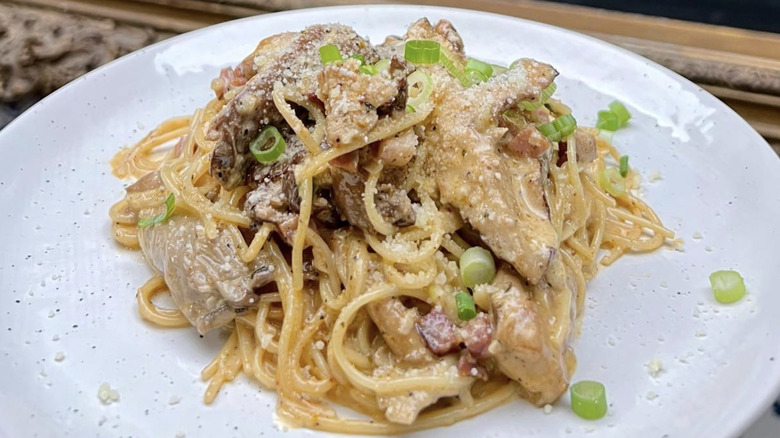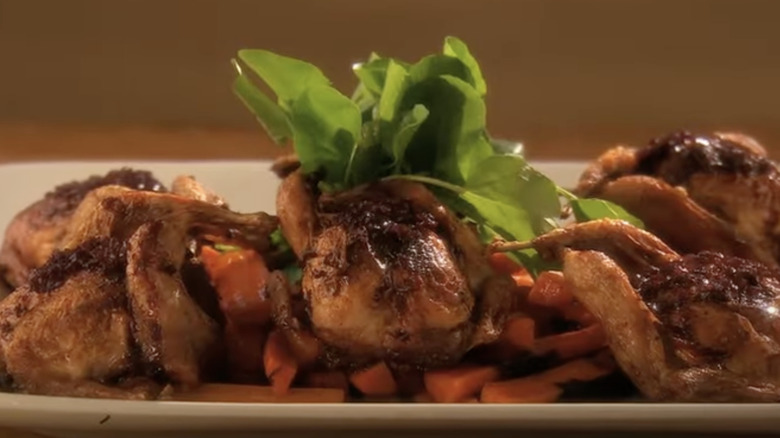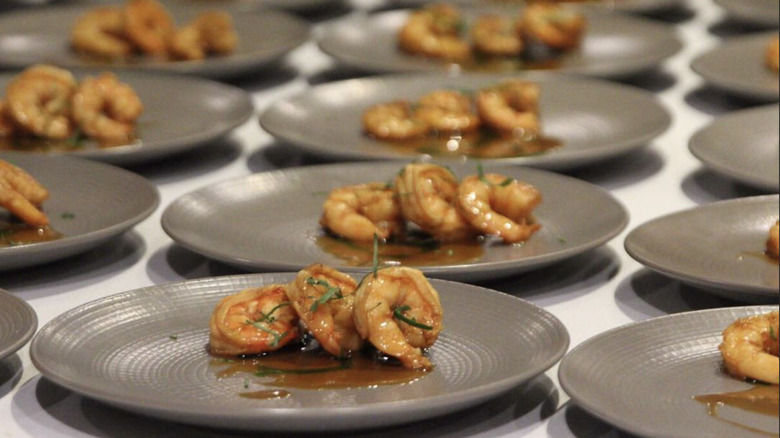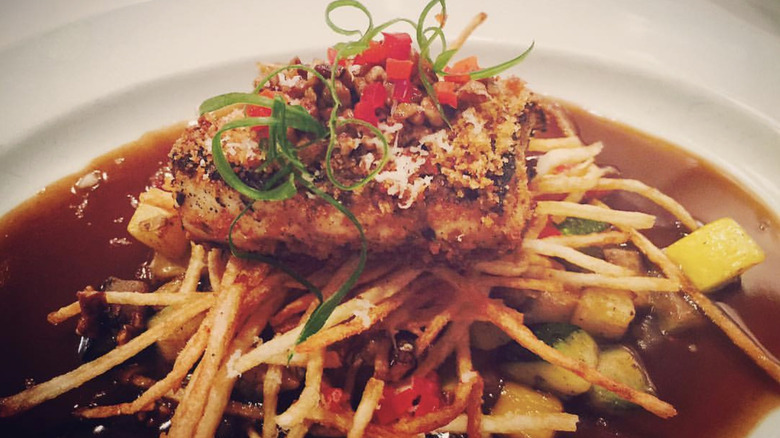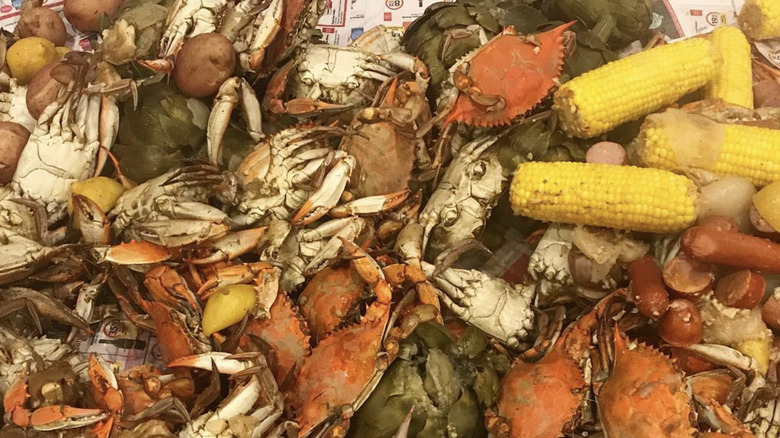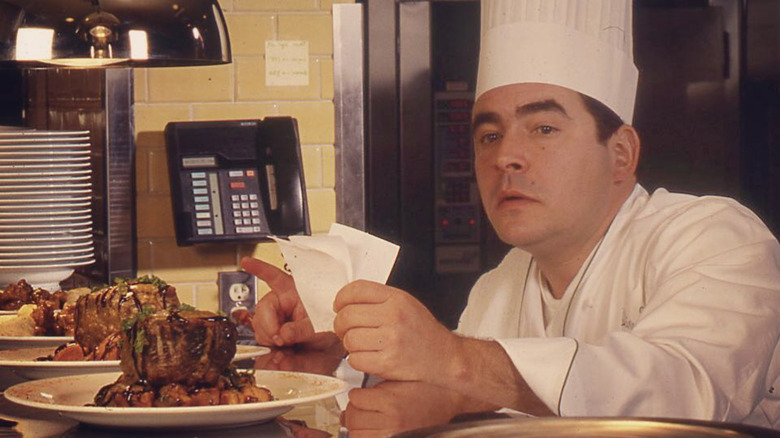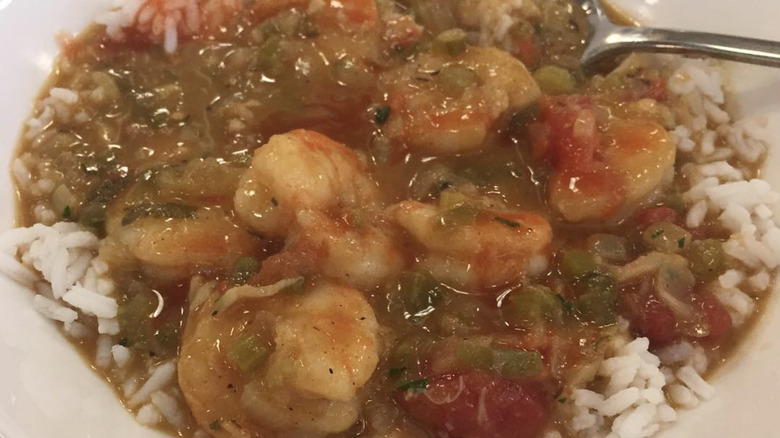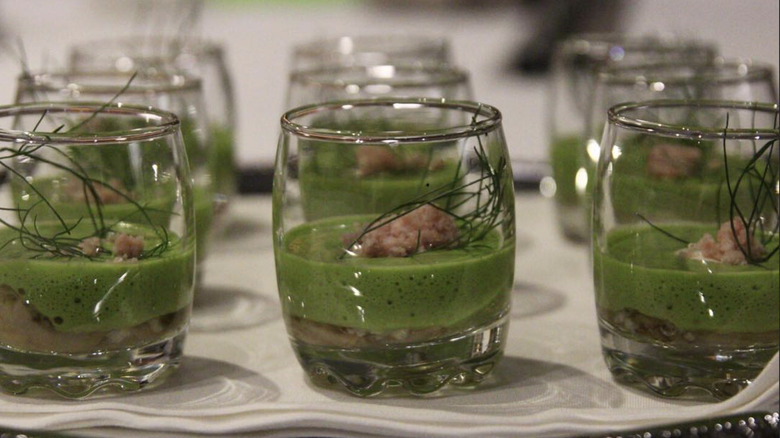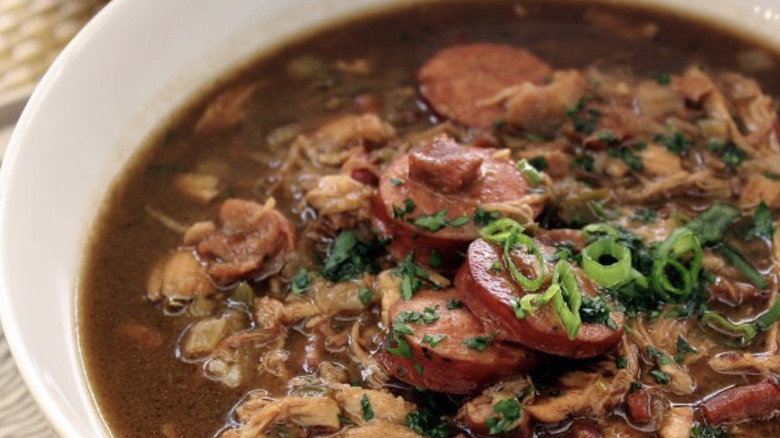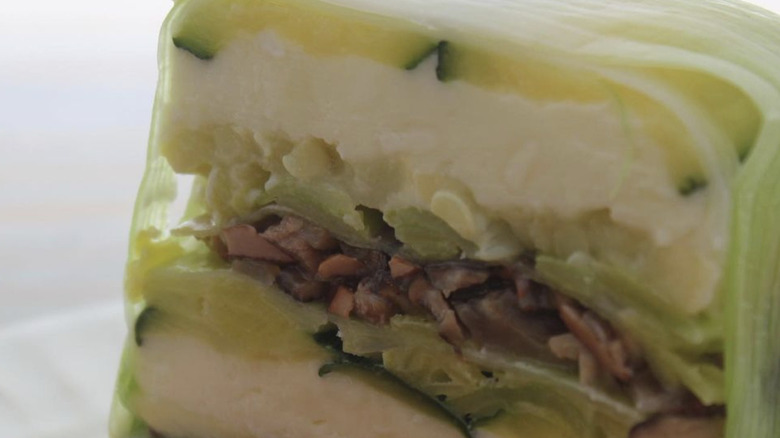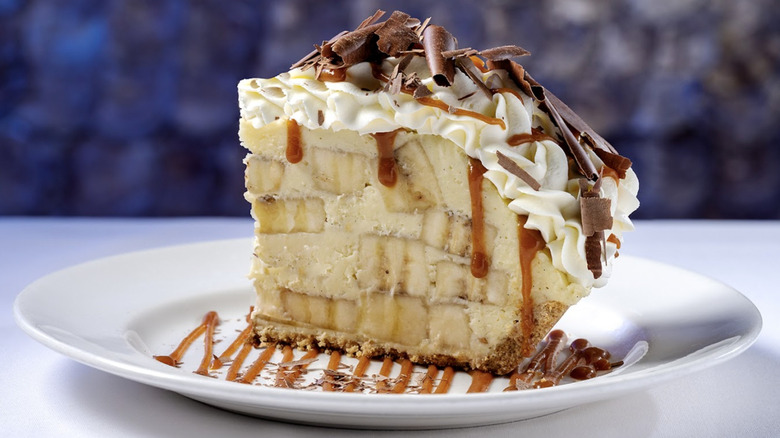The Influences That Shaped Emeril Lagasse's Iconic Dishes
Emeril Lagasse was the toast of 90's era Food Network. In 1993, the network was in its infancy, and on the lookout for viable talent. Lagasse was one of its first cooking show hosts and quickly became one of the channel's most beloved stars. The then-33-year-old Lagasse stepped up to host "How to Boil Water", and charmed audiences with his working-class Massachusetts accent, shy yet warm grin, and what Food Network execs described as a twinkle in his eye. Food Network made Lagasse a household name through subsequent shows like "Essence of Emeril" and "Emeril Live!", yet he was already an accomplished chef with several iconic dishes to his name before television came calling.
Although Lagasse is a native of Fall River, Massachusetts, his adopted hometown is New Orleans, where he spent decades helming kitchens and learning the traditions of Creole and Cajun cuisine. His reverence for New Orleans' cultural traditions, its people, and its food is the true essence of Lagasse's cooking; with heart and soul radiating throughout each iconic dish. New Orleans is certainly Lagasse's most favored culinary muse, but it's not the sole inspiration behind the recipes he is known for. From his boyhood days in New England kitchens to the fellow chefs and friends he met along the way, we're looking back at some of Emeril Lagasse's most iconic dishes and the people and experiences that influenced them.
Caldo Verde (Kale Soup)
In his 2015 cookbook "Essential Emeril: Favorite Recipes and Hard-Won Wisdom from My Life in the Kitchen", Emeril Lagasse describes an early memory of picking vegetables in the family garden and climbing onto a step stool to reach the kitchen counter where his mother taught him how to make soup. Lagasse's mother Hilda is of Portuguese descent, and Lagasse cites "caldo verde", a Portuguese kale soup, as one of the prominent foods that shaped his formative years. Lagasse also associates kale soup with the festivals he played at throughout the Northeast as a percussionist in a Portuguese band writing, "A big part of any Portuguese festival is the food — caldo verde ... From the very beginning I've connected food with happy people and good music."
His mother and festival fare aren't the only associations Lagasse attributes to caldo verde. Growing up in Fall River, a town with a large Portuguese population, Lagasse met a woman named Ines Da Costa who ran a neighborhood restaurant called St. John's Athletic Club. Da Costa mentored the young Lagasse, and he came to consider her as a second mother. The two cooked alongside one another even after Lagasse found fame as a chef, and kept in touch until she died in 2011. Lagasse's recipe for St. John's Club Kale Soup is an homage to his childhood, but mostly to Da Costa, whom he described to The Standard-Times as " ... an exceptional person."
Skillet Cornbread
Emeril Lagasse's precocious interest in the culinary arts didn't stop short of his mother's kitchen tutorials or his mentorship at the local restaurant St. John's Athletic Club. As a youngster, Lagasse's mother would send him to the local Portuguese bakery to buy a daily loaf of bread. The sights and smells of the bakery enthralled Lagasse, who was so intrigued by the baking process that he convinced the owners to give him a job there — he was only 10 years old (and it was the 60's). The bakery owners took him on as a dishwasher, but also showed him how to make muffins, breads, and other pastries. It was here that Lagasse had made his mind up — he would become a chef.
One of the bread recipes he learned there was skillet cornbread. It's one of those beloved homestyle recipes that transcends various types of cuisine and is a dish that has always stuck with Lagasse. Years later, as Lagasse's food became more and more intertwined with Southern flavors, he kept skillet cornbread as part of his recipe rotation, although he "kicked it up a notch" by mixing in jalepeños or other ingredients that pack some punch. The childhood influences that shaped this particular dish came full circle when Lagasse learned that his wife Alden's grandmother also made her cornbread this way. Now, Lagasse has a skillet cornbread recipe inspired by her that incorporates cheddar and bacon.
Angel Hair Pasta With Smoky Mushrooms and Tasso
When Emeril Lagasse was offered a full scholarship to the New England Conservatory of Music for his percussion skills, his desire to become a chef was so strong that he turned it down, and instead paid his way through culinary school. By 1982, 23-year-old Lagasse, who had cooked in kitchens as far away as France, found himself as the new executive chef of Commander's Palace, a New Orleans restaurant that had operated in the city's Garden District since 1893. The expansive eatery served Haute Creole cuisine and thrived under its previous executive chef Paul Prudhomme, a man who arguably put modern Creole and Cajun cuisine on the map in the 1970s and 80s. Those were big shoes to fill, and Lagasse knew it.
With guidance and encouragement from Commander's Palace owners Richard and Ella Brennan, Lagasse felt confident to reinterpret Creole style with a brand new dish: Angel Hair Pasta with Smoky Mushrooms and Tasso. To perfect the flavors, Lagasse needed a smoker, but Richard Brennan advised that smokers were prohibited in the Garden District. When Brennan left the restaurant between lunch and dinner, a determined Lagasse snuck a tabletop smoker inside the kitchen, and smoked the mushrooms and tasso ham to maximize their deep, rich flavors. Lagasse's new dish was a huge hit at Commander's Palace, proving that the young chief had the nerve and skill to shake up the customary Creole traditions.
Quail Milton
In 1990, after nearly eight years as executive chef at Commander's Palace, Emeril Lagasse was ready to open his own New Orleans restaurant, Emeril's. Lagasse had never opened a restaurant before and began to realize how many legalities were involved in bringing Emeril's to life. Obtaining all of the necessary permits required Lagasse to meet with the district Councilman at City Hall. To move this arduous process along, Lagasse did his homework. The district Councilman's nickname was Milton, and Lagasse found out that one of his favorite dishes was quail. Lagasse arrived at the Councilman's office and presented him with a very special dish: Quail Milton.
Quail Milton consists of oven-roasted quail stuffed with wild mushroom and andouille sausage duxelles, served on a bed of tender vegetables, and drizzled with a luxurious port wine sauce. The plan played out perfectly. Milton was a fan and Lagasse succeeded in getting all of the permits he needed. To this day, Lagasse credits Milton with playing an integral role in the opening of Emeril's. Quail Milton became a signature dish of Lagasse's and was featured on the menu at Emeril's for decades.
Barbecued Shrimp With Petite Rosemary Biscuits
If Emeril Lagasse's namesake restaurant Emeril's was going to be successful, the chef needed to literally bring food to the table that they couldn't get anywhere else. Back in 1990, opening a white tablecloth restaurant in New Orleans' Warehouse District was unheard of — so was serving barbecued shrimp in a fine dining establishment.
Barbecue shrimp is a traditional New Orleans delicacy, popularized in the 1950s through a restaurant called Pascal's Manale. The shrimp are served with the heads on slathered in smoky barbecue sauce and served alongside warmed slices of French baguette. Sounds delicious, but it also sounds messy. Lagasse wanted diners to enjoy barbecue shrimp at Emeril's without having to worry about getting their hands dirty. He decided to serve the shrimp peeled, but used the shrimp heads for the sauce so as not to sacrifice any flavor. Instead of a French baguette, Lagasse offers up to four petite rosemary biscuits.
In the now legendary August 1990 review of Emeril's, for which food critic Gene Bourg awarded his first-ever perfect rating of "five beans", Lagasse's barbecued shrimp was described as "a knockout." In 2020 Lagasse spoke to People magazine about the enduring legacy of the barbecued shrimp at Emeril's saying, "It's been on the menu since day one and is still, hands down, the number one dish."
Andouille-Crusted Redfish
The influence of Chef Paul Prudhomme, Emeril Lagasse's predecessor at Commander's Palace, continued to be a source of inspiration even after Lagasse struck out on his own at Emeril's. Prudhomme was famous for starting the blackened redfish craze in New Orleans, he was also a big believer in utilizing local resources, like the redfish native to Louisiana's Gulf Shores. Lagasse felt the same way, but he was determined to create a redfish entrée that was completely novel to the Cajun and Creole cookery of yesteryear.
Enter the Andouille-Crusted Redfish, an enticing filet that's big on flavor and originality. Using tasso ham, andouille sausage, and a generous smattering of cayenne pepper, Lagasse creates a crust for his redfish that is hearty, zesty, and inventive. Served on a bed of roasted pecan vegetable relish layered with shoestring potatoes, Lagasse's take on Cajun-style redfish is a winner. The Andouille-Crusted Redfish was on the original menu at Emeril's, and has come to be known as one of the chef's most iconic dishes.
Creole Seafood Boil
When Emeril Lagasse arrived in New Orleans in the 1980s, he threw himself into learning how the locals approached food. One of Southern Louisiana's signature foods is the Creole seafood boil, and it became something of a trademark dish for Lagasse as well. One of his earliest televised appearances was on the first season of Julia Child's show "Cooking With Master Chefs" where he demonstrated how to prepare some of New Orleans's most loved dishes.
In the segment, Lagasse took it outside to get his seafood boil on, showing viewers how to season the water before heaping mounds of andouille sausage, crawfish, blue crabs, potatoes, onion, garlic, corn, asparagus, and jumbo artichokes into the massive pot. You could see an early star quality bubbling up in the youthful chef as he explained the basics of a Creole seafood boil, but the most memorable part was Lagasse pouring the seafood boil contents onto a paper-lined patio table, and showing Julia Child how to peel and eat crawfish. Today, you can still see a version of the Creole seafood boil on the menu at Emeril's, a nod to the New Orleans, which so thoroughly shaped Lagasse's career, and perhaps also a nod to Julia Child, the iconic television chef who Lagasse cites as one of his biggest culinary influences.
Tamarind-Glazed Double-Cut Pork Chop With Mole Cream and Roasted Sweet Potatoes
Emeril Lagasse has penned 19 cookbooks and opened more than 20 restaurants throughout the United States, yet it's the boldly creative turns he made in the kitchen in the early 90s that endure as his most iconic. Lagasse's Tamarind-Glazed Double-Cut Pork Chop with Mole Cream and Roasted Sweet Potatoes, an early favorite at Emeril's, draws from Spanish, Mexican, and Southwestern influences rather than solely from the spirit of The Big Easy. Lagasse's open-minded point of view as a chef is still credited with shaking up the New Orleans food scene; his tamarind-glazed pork chop — a fusion-like dish — is representative of that.
Lagasse's go big or go home mentality in the kitchen is reflected by the hefty size of the double-cut pork chop, while the thought-provoking combination of the tamarind, mole cream, and sweet potatoes bring finesse to the meal. Unafraid to venture down culinary paths that lead to big flavor, Lagasse was one of the first fine dining chefs to showcase Southwestern influences in Creole and Cajun-style cooking and even developed his own Southwest seasoning — one of many of his spices that was sold in stores. Above all, Lagasse laid claim to a distinct point of view in his food, a quality we expect to see in all top-tier chefs of today.
Shrimp Etouffee
Emeril Lagasse's appearance on Julia Child's show "Cooking with Master Chefs" is best remembered for Lagasse and Child bonding over a couple of beers and a massive Creole seafood boil, but earlier in the episode Lagasse displayed his affinity for classic New Orleans cooking by making shrimp étouffée. He explained key distinctions between a standard mirepoix, which uses celery, carrots, and onions, and a Creole mirepoix which uses bell pepper onion, celery, and garlic. This was also one of the first glimpses viewers got to see of Lagasse making a roux — something that became a calling card for him as he ascended to Food Network stardom.
What stands out in Lagasse's shrimp étouffée demonstration is not just how baby-faced and soft-spoken he is (not a BAM! was heard), there's also his natural ability to teach the audience about étouffée's cultural significance while simultaneously breaking down what seems like a pretty complicated dish to make. The connection he feels with the tradition surrounding Louisiana's regional food is clear to see, as is an inherent charisma that helped turn Lagasse into a household name.
Oyster Rockefeller Soup Garnished With Crispy Bacon and Fried Oysters
Oysters Rockefeller may conjure visions of New York, but the famous appetizer was born at Antoine's restaurant in New Orleans in 1889. Its creator, Jules Alciatore came up with Oysters Rockefeller as an alternative to escargot, and the idea took off. Emeril Lagasse explains in his cookbook "Essential Emeril: Favorite Recipes and Hard-Won Wisdom from My Life in the Kitchen" that almost every New Orleans chef has their own version of Oysters Rockefeller, and his is a creamy, spinachy soup packed with oyster flavor.
Lagasse's relationship with shellfish dates back to his New England childhood. When he arrived in New Orleans, he accompanied local oyster luggers on excursions in the Gulf to get a feel for all that Louisiana's waters had to offer. Lagasse's Oyster Rockefeller Soup is primarily served at Lagasse's restaurants as a holiday specialty, its beautiful verdant color suited perfectly to the festive season. Topping the soup with crispy bacon and fried oysters adds a playful, indulgent twist to an already standout recipe.
Chicken and Andouille Gumbo
No New Orleans chef can truly satisfy the locals without an awesome gumbo recipe up their sleeve. Emeril Lagasse has more than a few but says his favorite gumbo flavor combination is chicken and andouille pork sausage, a smoky, savory stew of a dish served on a bed of boiled white rice. Gumbo is perhaps the quintessential dish of historic New Orleans, with roots in West Africa, and an appeal that transcends the barriers of race and class.
Lagasse has made his chicken and andouille gumbo on Food Network where he showcased his roux-making expertise, advising his trusting audience that creating the layers of a roux was like building a house and required a mirepoix of what he called "the holy trinity" of onions, celery, and bell pepper. Like so much of Lagasse's New Orleans' influenced cooking, he took liberties with his gumbo, and yet his chicken and andouille version is a crowd-pleaser perfect for tailgates and Mardi Gras celebrations.
A Vegetable Terrine For Charlie
Emeril Lagasse has always been known to cook from the heart, and his Vegetable Terrine For Charlie is a profound example of that. Charlie Trotter was a Chicago chef and Lagasse's contemporary who was integral in making the Windy City the dining destination it is today. Lagasse struck up a friendship with Trotter, which he reflects upon in his "Essential Emeril" cookbook saying, "We shared a passion for wine, and we travelled together often, chasing the world's great restaurants and wineries in this county, France, and Italy."
When the two collaborated on charity dinners and other events, Lagasse says that Trotter's go-to dish was a terrine due to its portability and wow factor, " ... guinea hen terrines, pigeon terines, crawfish terrines, lobster terrines, — he was the terrine king." After trotter's untimely death in 2013 at the age of 54, Lagasse was compelled to craft an elegant vegetable terrine for his dear friend that is both beautiful to look at and a satisfying, delicious dish to share with guests. Succulent layers of green veggies, goat cheese, and mushroom duxelles are a notably versatile recipe from Lagasse, but more than anything, it is a gorgeous tribute to true friendship.
Emeril's Banana Cream Pie
Did we save the best for last? Maybe. Emeril Lagasse's greatest recipes span from an upbringing marked by eclectic culinary influences, triumphs in fine dining, and groundbreaking work in the world of food TV. Through it all, there was banana cream pie. As a pre-teen, Lagsse cut his teeth at a neighborhood bakery in Fall River, Massachusetts, but notes that pastry decorating was not a trick of the trade for Portuguese bakers.
In his "Essential Emeril" cookbook, Lagasse writes, "When I was growing up, it wasn't enough just to eat my dessert. I wanted to know how to make it, so much so that I took a cake decorating class." At Emeril's, Banana Cream Pie has been on the menu since day one. Times-Picayune food critic Gene Bourg's iconic 1990 review of Emeril's titled "Long May It Live" waxes poetic over Lagasse's signature dessert with the sentiment, "Finally, they can seal the devil's pact with the best banana cream pie that God allows to descend to Earth — in a banana-caramel crust, yet."
Lagasse's mother made banana cream pie in his boyhood days, but in true Lagasse fashion, he put an extra touch on the formative influence. Every banana cream pie contains no less than ten bananas. Each slice is individually piped with whipped cream, drizzled with caramel sauce, doused in chocolate shavings, and fortified by a graham cracker crust. To this day, you can find this dessert at almost every one of Lagasse's restaurants.
